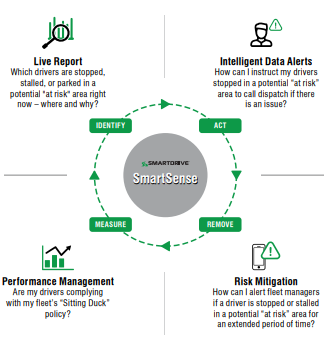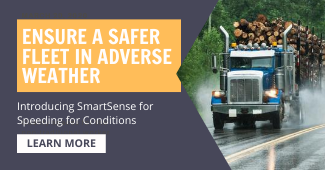August 18, 2020
In my previous blog post, I illustrated how the methodology presented could be used in a real-world example – identifying vehicles unsafely parked along an interstate – and delivered in our new SmartSense for Sitting Duck. In this post, I’ll show you how the same set of steps can be used to provide a solution to another challenge facing fleets – driving too fast given the current weather conditions.
What do we mean by Driving too fast given the current weather conditions? Here is a working definition of the problem:
Identifies situations where drivers are driving too fast for weather conditions (rain, snow, ice, fog) based on a company’s customizable speed threshold policy or FMCSA standards
Note that the statement doesn’t say driving under the posted speed limit. Importantly, even if the truck is traveling below the posted speed limit, it still may be traveling too fast given the type of weather.
Why is this important? Inclement weather is 1 of the top 5 common causes of trucking accidents. We have also determined that 23% of truck crashes occurred when drivers were traveling too fast for weather conditions. In addition, 46% of weather-related fatalities are due to rain, 13% due to snow and 9% due to fog.
When “Speeding for Conditions” occurs, the need to identify the issues as soon as possible is extremely important. By notifying the driver as the event is occurring, you can alert the driver to slow down and reduce the risk of an incident due to unsafe speed.
So, how does the analytics team at SmartDrive solve for this problem? Let’s use the steps from my first blog post to see how they can be applied to this issue.
Steps
Understand and articulate the problem you are trying to solve
The goal is to identify vehicles that are traveling too fast given the current weather conditions (even if they are traveling below the posted speed) and remediate the situation as quickly as possible. In our example, remediation takes the form of in-cab alerting to the driver and escalation to supervisors – along with driver coaching – to prevent this type of behavior in the future.
Identify data sources and types of data available to answer your business questions
We need the following information (which must be available in real-time, i.e., as the events occur):
- The location of the truck (GPS coordinates)
- The current speed of the truck
- The current weather condition the truck is in (based on its location)
- A set of rules that are consulted to determine a safe traveling speed
What do we have?
The SmartDrive system produces real-time telematics data, which is enriched with additional information, to determine the risk level at a time and location. This enriched data set covers items #1 – #2
An advanced rule engine is used to define and process a set of rules that cover item #4. SmartDrive provides a base set of rules representing best practices we have determined from the FMCSA guidelines and historical information we have captured over the years. In addition, we allow customers to define, or modify, the rules with ones that match the type of behavior they want their drivers to model.
What additional data do we need and can get?
The current weather at a given location is critical for this solution to work. There are many on-line services available that provide up-to-date weather information. However, it’s very important to ensure the service can handle the volume of requests that may be generated from large fleets and is able to return results in a timely manner. Having weather information that is even a few minutes late could provide inaccurate results.
Define the audience to whom you are communicating your results
There are two groups we are looking to inform (based on our problem statement):
- The drivers
- The drivers’ supervisor and/or fleet safety managers
The key is to have the drivers notified as soon as possible so that they take corrective actions and eliminate the risk associated with traveling too fast for the conditions. Ultimately, the goal of the solution is to prevent accidents that can be attributed to weather conditions.
The supervisors and fleet safety managers are notified if the condition continues to persist after driver notification, i.e., an escalation. This allows additional steps to be performed to remediate the situation.
Most analytics solutions (this one included) should produce actionable data and reporting that allows the fleet to understand how it’s performing and any trending, either good or bad.
What additional insights have we learned?
As we built the solution, we learned the following points:
- Any service will have down-time and unexpected delays, as is the case with weather service providers. Sometimes the data is delayed or is missing key components. Our solution must tolerate these types of data errors and still continue to provide a high level of service.
- Weather is a tricky event to classify. Is “heavy rain” much different from “medium rain?” Using a Rule Engine enabled us to write rules that accurately represented our intentions.
- We also determined that combinations of weather events (e.g., rain with thunder) provided additional information – materially changing what our rule set looked like
- We quickly realized that, in addition to determining safe speed, the Rule Engine could be used to orchestrate the workflow process (e.g., notify a tenured driver three times before notifying a supervisor vs. notify a new driver only once before escalating).
Summary
Even if a truck is traveling below the posted speed limit, it could be at a higher risk of being involved in an accident if it’s traveling in adverse weather conditions.
Being able to identify these unsafe speed events via a set of configurable rules as quickly as possible, can materially lessen the risk exposure to fleets.
Fleets may have their own tolerance levels for which speeds are appropriate for a given weather situation; by including a rule engine in the offering, SmartDrive allows customers the ability to augment the ‘rules of engagement’ that are used to identify unsafe speeds.
By clearly defining the problem statement, understanding what data we have and what we need to get, we built a solution that matches the requirements and allows for future expansion as we become smarter by observing real-life events. Learn more about SmartSense for Speeding for Conditions.
